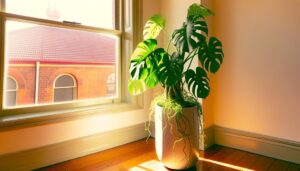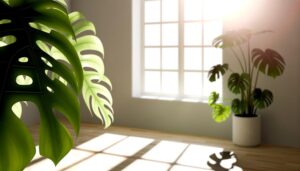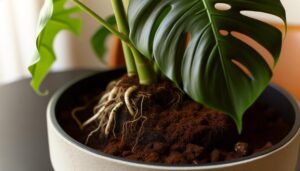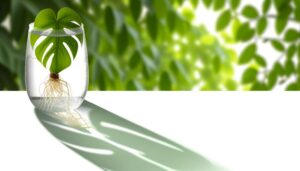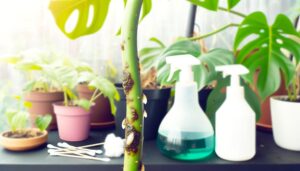Best Light for Monstera Deliciosa: Ultimate Guide!
Monstera Deliciosa flourishes in bright, indirect sunlight, mimicking the dappled light of its native tropical environments. Peak growth is observed under light levels of 10,000 to 20,000 lux.
Place near east or west-facing windows to offer filtered light, avoiding the risk of leaf burn. Using a light meter guarantees precise monitoring of conditions, maintaining 100-500 foot-candles.
In winter, consider supplemental lighting to make up for reduced natural light. Avoid direct sunlight surpassing 50,000 lux to prevent chloroplast damage.
Strategic rotation guarantees uniform light exposure, improving foliage health. Explore ideal care practices and advanced light management techniques to support your Monstera’s growth.
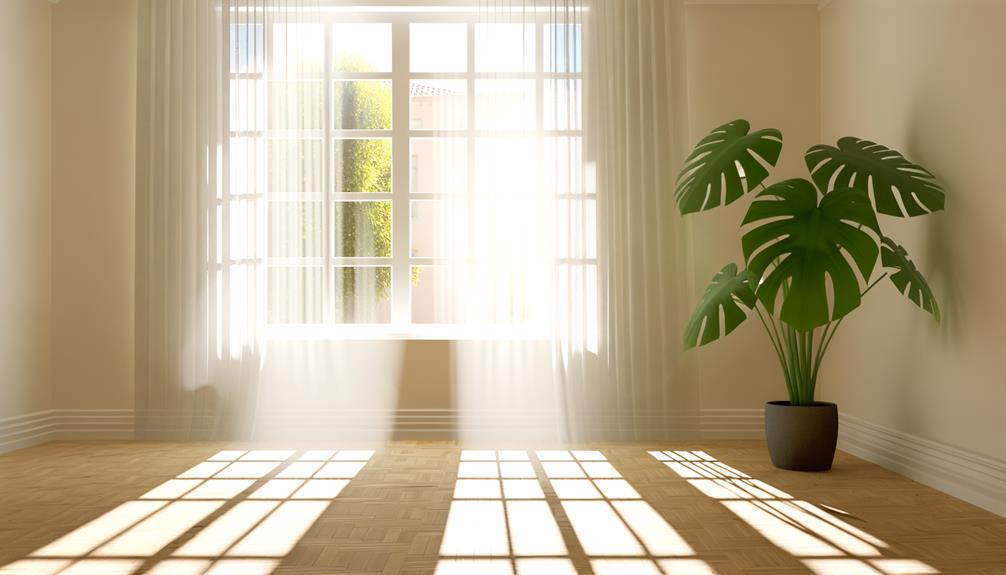
Key Takeaways
- East or west-facing windows provide the ideal bright, indirect sunlight for Monstera Deliciosa.
- Avoid direct sunlight exceeding 50,000 lux to prevent leaf damage and chloroplast degradation.
- Maintain light levels between 10,000 to 20,000 lux for optimal growth and health.
- Use LED grow lights with adjustable intensity for consistent 12-16 hour light exposure during darker months.
- Rotate the plant every two weeks to ensure even light distribution and prevent etiolation.
Natural Light Requirements
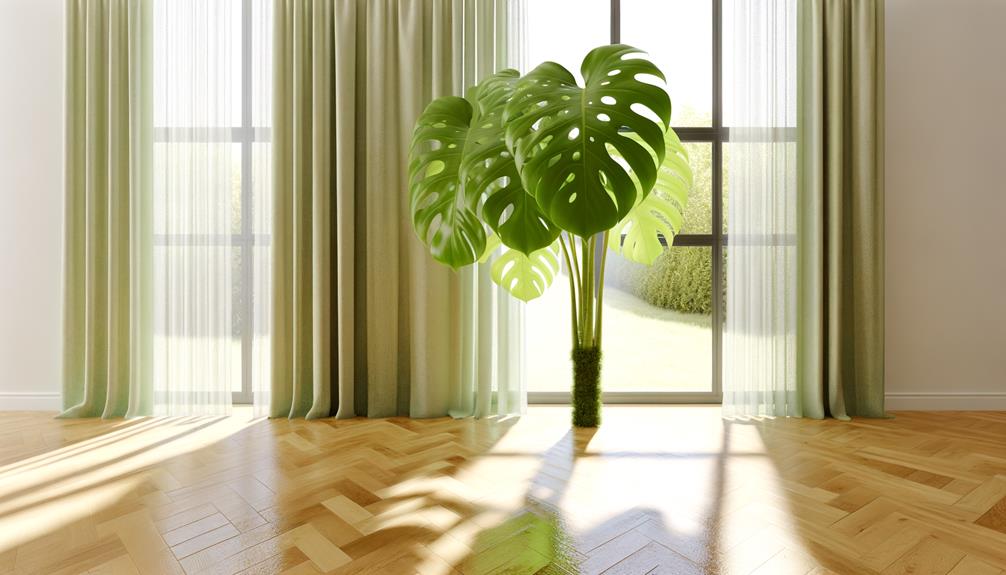
Monstera Deliciosa thrives best in bright, indirect sunlight, as direct exposure can cause leaf burn and hinder its growth. Empirical evidence suggests that the plant’s large, fenestrated leaves are adapted to dappled light typical of tropical understories.
Studies indicate that photosynthetic efficiency is maximized under indirect light conditions, with best growth observed at light levels around 10,000 to 20,000 lux. Direct sunlight, exceeding 50,000 lux, can damage chloroplasts, leading to photoinhibition and cellular damage.
Additionally, indirect sunlight promotes consistent leaf pigmentation and the development of characteristic leaf perforations. For optimal health, it is vital to monitor light intensity using a light meter, ensuring exposure remains within the ideal range, supporting robust vegetative growth and overall plant well-being.
Ideal Window Placement
When considering the ideal window placement for Monstera Deliciosa, it is important to account for the best light direction, mainly east or west-facing windows, which offer bright, indirect sunlight. Direct exposure to sunlight should be minimized to prevent leaf burn, highlighting the importance of filtered light conditions.
Additionally, seasonal light variations must be handled to maintain consistent light intensity throughout the year, adjusting placement as needed.
Optimal Light Direction
Positioning your Monstera Deliciosa near an east-facing window guarantees it receives excellent morning light, which is both bright and indirect, promoting vigorous growth and minimizing the risk of leaf scorch.
Scientific observations indicate that morning light is less intense compared to afternoon sunlight, thereby providing a balanced photosynthetic response. East-facing windows typically allow for 2-4 hours of ideal light, ensuring sufficient energy for photosynthesis without the detrimental effects of excessive heat or UV radiation.
Additionally, indirect light conditions foster chlorophyll production while preserving the integrity of the foliage. For locations devoid of an east-facing window, positioning near a north-facing window or utilizing sheer curtains can replicate these conditions, ensuring the Monstera Deliciosa thrives in less than ideal environments.
Avoid Direct Sunlight
Direct sunlight exposure can lead to photodamage in Monstera Deliciosa, resulting in scorched leaves and impaired photosynthetic efficiency. To mitigate this risk, ideal placement near an east or north-facing window is recommended. Such locations provide diffused, indirect light, which is more favorable to the plant’s growth.
Research indicates that Monstera Deliciosa thrives under light conditions ranging from 200 to 500 foot-candles.
Excessive direct sunlight, characterized by light intensities exceeding 1,000 foot-candles, can cause cellular damage and disrupt chlorophyll function. Utilizing sheer curtains can further diffuse light, creating a more consistent photic environment.
Ensuring proper light conditions enhances photomorphogenic responses and supports overall plant health, maintaining the aesthetic and physiological integrity of Monstera Deliciosa.
Seasonal Light Changes
Due to variations in the angle and intensity of sunlight throughout the year, the best window placement for Monstera Deliciosa must account for seasonal changes to maintain consistent access to suitable light levels.
During summer, positioning near an east-facing window will provide ideal morning light while avoiding the harsh afternoon sun, which can cause leaf burn.
Conversely, in winter, relocating to a south-facing window guarantees sufficient light exposure despite shorter daylight hours and lower sun angles.
Empirical studies suggest that maintaining a consistent light duration of approximately 6-8 hours per day is essential for optimal growth.
Regularly rotating the plant also guarantees uniform light distribution, preventing etiolation and promoting balanced development.
Light Intensity

Best light strength for Monstera Deliciosa is crucial for its physiological processes, as it directly impacts photosynthesis and overall plant health.
Peak light strength falls within the range of 100 to 500 foot-candles, which mimics the dappled sunlight of their native tropical understory habitat.
Inadequate light results in etiolation, characterized by elongated stems and smaller leaves, while excessive light can lead to photoinhibition, causing leaf burn and stunted growth.
Using a light meter can guarantee precise measurements, thereby facilitating an environment conducive to robust development.
Empirical studies have shown that maintaining this ideal light strength enhances chlorophyll production and maximizes the plant’s photosynthetic efficiency, ultimately promoting vigorous growth and ornamental foliage.
Seasonal Light Changes
Understanding the best light strength is essential, but it is equally significant to recognize how seasonal light changes impact Monstera Deliciosa’s growth patterns and physiological responses.
During the winter months, shorter daylight hours and reduced light strength can lead to slower growth and elongated internodes due to etiolation.
Conversely, in the summer, increased light duration and strength stimulate robust growth and leaf fenestration.
Evidence indicates that Monstera Deliciosa adapts its chlorophyll concentration and photosynthetic activity in response to these seasonal variations.
Ensuring ideal light conditions year-round may necessitate supplemental lighting during darker months and strategic positioning to avoid excessive direct sunlight during peak summer.
This nuanced understanding is optimal for maintaining the plant’s health and aesthetic appeal.
Signs of Too Much Light
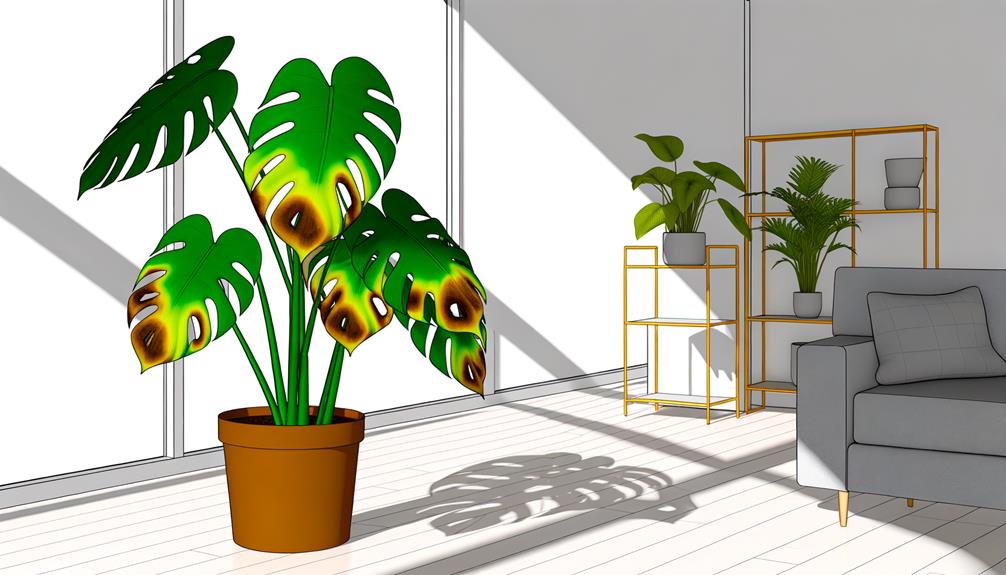
Excessive light exposure manifests in Monstera Deliciosa through symptoms such as leaf burn, characterized by scorched or bleached patches and crispy edges. Such photodamage occurs when the chlorophyll in the leaves degrades under intense light, disrupting photosynthesis.
This degradation is often accompanied by necrosis, where leaf tissue dies, leading to brown, brittle spots. Additionally, excessive light can cause accelerated transpiration rates, resulting in water stress and subsequent wilting.
Empirical observations suggest that sustained exposure to direct sunlight, especially during peak midday hours, exacerbates these symptoms. It is advised to position Monstera Deliciosa in indirect, filtered light conditions to mitigate the risk of photodamage and promote the best physiological health.
Signs of Insufficient Light
Insufficient light exposure in Monstera Deliciosa typically results in etiolation, where the plant exhibits elongated, leggy stems and sparse foliage due to inadequate photosynthetic activity. This condition can detract from the plant’s overall aesthetic and health.
Key indicators of inadequate light include:
- Extended Internodes: Noticeably longer spaces between leaf nodes, a clear sign of the plant stretching toward a light source.
- Pale or Yellowing Leaves: Chlorosis occurs due to reduced chlorophyll production, impairing photosynthesis.
- Leaf Droop: Leaves may become limp and droopy as the plant fails to generate enough energy for turgidity.
- Reduced Leaf Size: New leaves may emerge smaller and less fenestrated, indicating suboptimal growth conditions.
Recognizing these signs is essential for maintaining a thriving Monstera Deliciosa.
Artificial Light Options
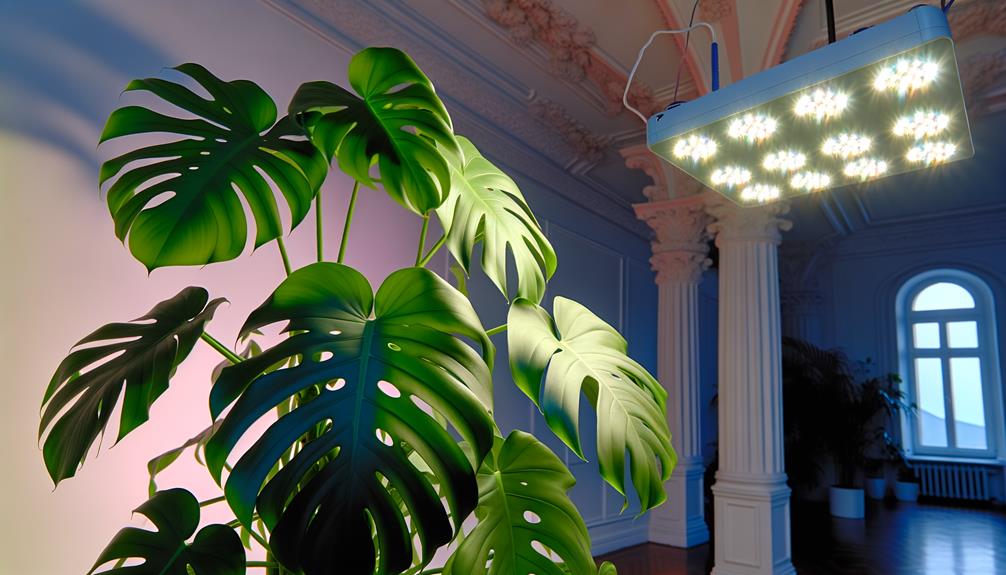
Selecting the suitable artificial light options for Monstera Deliciosa is essential for replicating natural sunlight and ensuring optimal plant health and growth.
Fluorescent lights, particularly T5 and T8 tubes, are highly effective due to their full-spectrum output, which closely mimics natural daylight.
LED lights, especially those labeled as full-spectrum, are another excellent choice, offering energy efficiency and longevity.
Compact fluorescent lamps (CFLs) can also be used, though they typically provide less light intensity compared to fluorescent tubes and LEDs.
When selecting artificial light, consider the light’s color temperature, ideally between 5000K and 6500K, to simulate daylight conditions.
Additionally, ensuring a proper light schedule that mimics natural day length is crucial to support the Monstera’s photosynthetic needs.
Using Grow Lights
When considering grow lights for Monstera Deliciosa, it is essential to evaluate the types of grow lights available, such as fluorescent, LED, and incandescent, each offering unique spectral outputs.
The light intensity requirements must be tailored to the Monstera’s native tropical habitat, typically needing a range of 200-400 PPFD (Photosynthetic Photon Flux Density).
Additionally, the best light duration should simulate natural daylight cycles, ideally maintaining 12-16 hours of light exposure per day to support robust growth and development.
Types of Grow Lights
Various types of grow lights, including LED, fluorescent, and HID (High-Intensity Discharge), offer distinct advantages and performance characteristics that can greatly influence the growth and health of Monstera Deliciosa. Each type of grow light serves specific functions based on spectral output, energy efficiency, and heat emission.
- LED Grow Lights: Offer full-spectrum light, energy efficiency, and low heat emission, ideal for indoor environments.
- Fluorescent Lights: T5 and T8 tubes provide a broad spectrum and are cost-effective, but they generate more heat.
- HID Lights: High output and penetration, suitable for larger setups but consume more power and produce significant heat.
- CFL (Compact Fluorescent Lights): Compact and easy to install, providing a balanced spectrum but with moderate energy efficiency.
Choosing the appropriate grow light depends on specific horticultural requirements and spatial constraints.
Light Intensity Requirements
Understanding the light intensity requirements for Monstera Deliciosa is crucial for enhancing its growth and health, especially when using artificial grow lights. Research indicates that Monstera Deliciosa thrives in medium to bright indirect light, with an ideal Photosynthetic Photon Flux Density (PPFD) range of 100-350 μmol/m²/s.
Employing LED grow lights with adjustable intensity settings allows for precise control, ensuring the plant receives sufficient light without the risk of photodamage. Empirical evidence suggests using full-spectrum LED lights, which replicate natural sunlight and support vigorous photosynthesis and morphological development.
Monitoring light intensity with a quantum light meter can improve accuracy, ensuring that the PPFD remains within the recommended range, thereby creating an excellent environment for Monstera Deliciosa’s growth.
Optimal Light Duration
Determining the best light duration for Monstera Deliciosa under grow lights is essential to mimic its natural growing conditions and maximize photosynthetic efficiency. Research suggests that a photoperiod of approximately 12-16 hours per day is ideal. This duration closely mimics the tropical environment where Monstera Deliciosa thrives.
To achieve this ideal light duration, consider the following guidelines:
- Set Timers: Use programmable timers to ensure consistent light exposure without manual intervention.
- Monitor Plant Response: Regularly observe leaf coloration and growth patterns to adjust light duration as needed.
- Avoid Light Stress: Ensure a dark period of at least 8 hours to prevent light stress and disruption of Circadian rhythm.
- Quality of Light: Utilize full-spectrum LED grow lights to provide balanced wavelengths for photosynthesis.
Light Duration
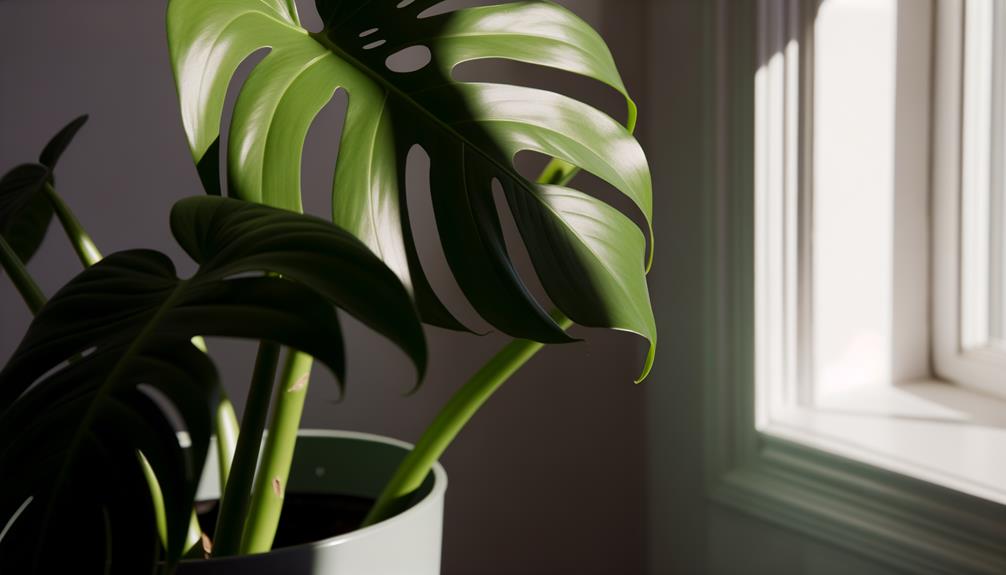
Ideal light duration for Monstera Deliciosa is essential for ensuring healthy growth and development, typically requiring 10 to 12 hours of indirect light daily.
This duration aligns with the plant’s natural habitat in tropical rainforests where it thrives under the canopy. Prolonged exposure to direct sunlight can lead to leaf scorch, while insufficient light results in leggy growth and poor leaf fenestration.
Studies indicate that consistent light cycles promote optimal photosynthesis, enhancing overall vigor and resilience. Utilizing artificial grow lights with a timer can help mimic these conditions, providing a reliable light source during shorter daylight periods. Ensuring a consistent light duration is pivotal for maintaining the Monstera’s lush, characteristic foliage.
Rotating Your Monstera
In addition to securing proper light duration, rotating your Monstera Deliciosa regularly is essential for promoting even growth and preventing asymmetrical development. This practice allows all sides of the plant to receive sufficient light, reducing the risk of phototropism where the plant excessively leans towards the light source.
Follow these steps for best results:
- Frequency: Rotate the plant approximately 90 degrees every two weeks to guarantee uniform exposure to light.
- Consistency: Maintain a consistent rotation schedule to avoid stress on the plant.
- Observation: Monitor the plant’s response to rotation, adjusting frequency if uneven growth is observed.
- Environment: Ensure the surrounding environment remains stable regarding light intensity and duration, irrespective of the plant’s orientation.
Light and Leaf Health
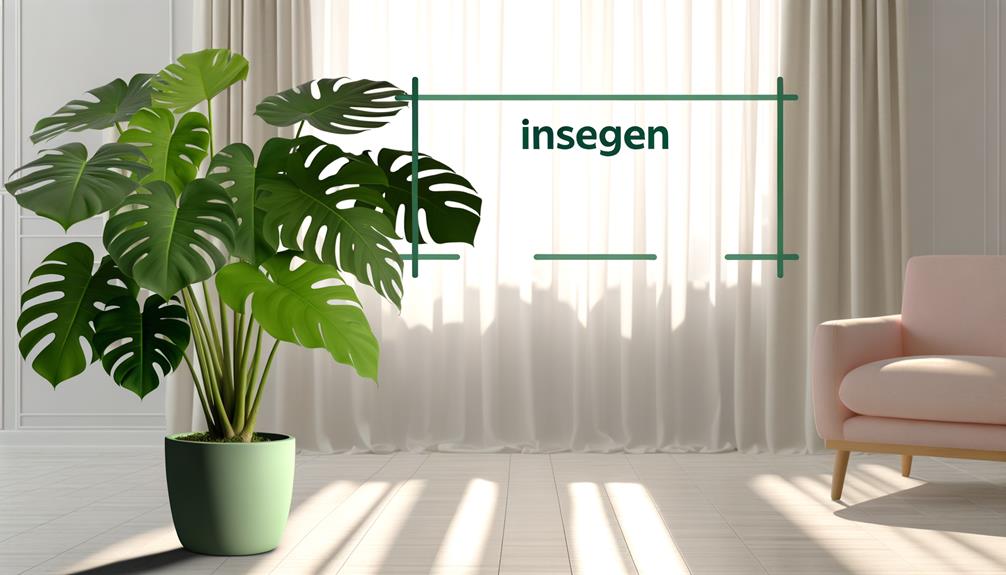
Proper light exposure is essential for Monstera Deliciosa, as subpar light levels can greatly impede photosynthesis and overall plant health.
Studies indicate that these plants thrive in bright, indirect sunlight, which enhances ideal leaf shape and fenestration.
Conversely, inadequate light can result in etiolation, marked by elongated stems and smaller, less colorful leaves.
Optimal Light Levels
To maximize brightness levels for Monstera Deliciosa, it is crucial to comprehend the interplay between light intensity and leaf shape. Insufficient or excessive light can greatly impact the plant’s photosynthetic efficiency and overall well-being. Optimum light conditions facilitate the formation of fenestrations (leaf holes) and enhance chlorophyll production.
Key considerations include:
- Light Intensity: Aim for 100-500 foot-candles; ensures sufficient energy for photosynthesis.
- Duration: 10-12 hours of indirect bright light daily; prevents leaf scorching.
- Quality: Full-spectrum light resembling natural sunlight; supports balanced growth.
- Distance: Position 2-3 feet from north or east-facing windows; avoids direct sun exposure.
Understanding these parameters allows for precise light management, promoting healthy Monstera Deliciosa foliage.
Impact on Growth
Monitoring the interplay between light conditions and leaf health reveals significant insights into the growth dynamics of Monstera Deliciosa.
Adequate light levels are crucial; inadequate light results in etiolation, characterized by elongated stems and smaller, less fenestrated leaves. Conversely, excessive light can cause photodamage, leading to chlorosis and necrotic leaf tips.
Empirical studies indicate that Monstera Deliciosa thrives under bright, indirect light, which promotes optimal photosynthetic activity and robust leaf morphology. The ideal photoperiod for maximizing growth is approximately 12-14 hours of diffused light daily.
Common Light Mistakes
One frequent error in caring for Monstera Deliciosa is exposing the plant to excessive direct sunlight, which can lead to leaf burn and reduced overall health. Proper light conditions are vital for ideal growth.
Common mistakes include:
- Positioning near south-facing windows: Direct afternoon sunlight can cause significant damage.
- Neglecting light diffusion: Failing to use sheer curtains or blinds to filter intense light results in scorched leaves.
- Inconsistent light exposure: Irregular lighting schedules can disrupt the plant’s growth cycle.
- Overcompensating with artificial light: Excessive use of grow lights without proper spacing can lead to overheating and photodamage.
Understanding these pitfalls enables better light management, ensuring robust health and vigorous growth for Monstera Deliciosa.
Conclusion
To sum up, Monstera deliciosa flourishes under specific light conditions that resemble its natural environment. Ideal positioning close to east or south-facing windows guarantees sufficient light intensity without the danger of scorching.
Seasonal changes and thoughtful rotation contribute to uniform growth and leaf health. Recognizing signs of excessive light, such as browning leaf edges, is vital.
By grasping these nuanced light needs, one can nurture a thriving Monstera, marked by luxuriant, vivid foliage and strong growth.

